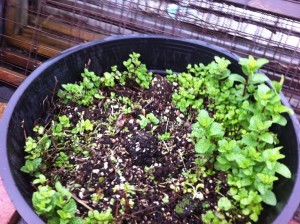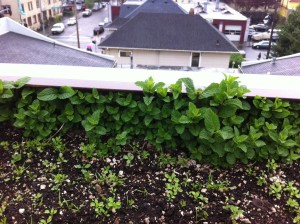 |
| You might toast someone’s health with a mojito in hand, but the mint that’s bound for the drink does not look so healthy. |
On the rooftop of the Noble Rot, we’re conscious that not all of the produce makes it onto the plate…and for good reason. Talk to any restauranteur and he or she will tell you that the money’s not to be made by plating up food, not matter how talented your line of cooks. The money’s at the bar, where social lubricants flow along with the cash. So, with that in mind we grow certain crops like mint. Mojitos are practically the lingua franca of any bar these days, and copious amounts of mint are consumed in their preparation. While our bartender is busy muddling it, the rooftop gardener (yours truly) is busy growing it.
Mint is the zucchini of the herb garden. It’s the no-fail crop. In fact, to extend the analogy, it can also burden you with its prodigious growth. Now you can’t really load your neighbor’s car with mint like you can with zucchini, or pranks like that, but you can fill up your or someone else’s garden with the stuff by planting only a tiny sprig. Herein lies the root of a problem which has bedeviled my mint growing. Only by casting away the myth of mint was I able to make a big breakthrough.
Many gardeners, living in fear of a Mint Apocalypse in their garden, have learned to tame the beast by planting it in containers. I have done the same and had success, especially when the container was a large pot, partly buried in the herb garden. The wall of the pot limits mint’s ability to reproduce through lateral, underground stems called rhizomes, while the drainage holes of the pot allow its true roots to access water and nutrients. When I took the mint-in-the-pot idea to the rooftop, though, I planted it in individual containers not buried in garden soil. What I found was that after a month or so the mint plants primarily circled around the edge of the pot (above photo) and the overall quality of the plant became diminished, even with plenty of water. Some acrid, unpleasant tastes cropped up in the leaves, and pretty soon it looked like these plants would be better suited to a drink called a Perdido than a Mojito.
That’s when I decided to make a radical break with tradition. I decided to let the mint run free in the deeper raised beds that we have against the north wall building. In my own garden at home, some of which is taken over by mint, I had also observed that when I got down to weed it, it actually was a bit of a sheep in wolf’s clothes. It came out very easily, and I was able to extract long rhizomes intact. How much moreso in the soft, often-cultivated soil of the rooftop garden, I thought?
 |
| Now here’s some mint that worth a bottoms up! |
So mint and I struck a bargain. It would have access to much more soil and nutrients than in a smaller container. In exchange, I demanded that it consequently be vibrant green, taste great, and that it roll over and die when and where I needed it to. So now, as in the photo below, it accessorizes the beds, tending to run along the back side, and I just mercilessly yank it out when I need the space that it is taking. It actually seems to thrive on this abuse, but I’m not going to anthropomorphosize anything into this, OK?
One word of caution: don’t compost the mint rhizomes, or if you do, make sure they dry down completely in the sun so they are mere lifeless strings of biomass. Otherwise the next time you spread your compost, you will be giving mint the signal that it’s got free reign over your entire garden.
So conquer your fear of mint, give it some room to spread while at the same time showing it who’s boss, and by all means drink those delicious mojitos responsibly.
